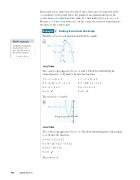Page 601 - Algebra 1
P. 601
Intercepts, zeros, and roots are related. An x-intercept of a function is the x-coordinate of the point where the graph of an equation intersects the x-axis. A zero of a function is the value of x that makes f(x) = 0, or y = 0. Because y = 0 for every value of x on the x-axis, the zeros of a function are the same as the x-intercepts.
Finding Zeros from the Graph
Find the zeros of each function shown in the graph.
a.
SOLUTION
The x-intercepts appear to be at -1 and 3. Check by substituting the ordered pairs (-1, 0) and (3, 0) into the function.
Example
2
Math Language
The zeros of a quadratic function f(x) = ax2 +
bx + c are the roots of the related equation
0=ax2 +bx+c.
4
f(x) = -x2+ 2x + 3
O
-4
-2
2
4
-2
y = -x2 + 2x + 3 0 -(-1)2 +2·-1+3 0 -1 - 2 + 3
0=0 ✓
The zeros are -1 and 3. b.
f(x) = 3x2+ 12x + 12
SOLUTION
y = -x2 + 2x + 3 0 -(3)2 +2·3+3 0 -9 + 6 + 3 0=0 ✓
-4
y
586 Saxon Algebra 1
y
4
2
O
x
-6
-4
-2
-2
The x-intercept appears to be at -2. Check by substituting the ordered pair (-2, 0) into the function.
y=3x2 +12x+12 0 3(-2)2 +12·-2+12 0 12 - 24 + 12
0=0 ✓
The zero is -2.


